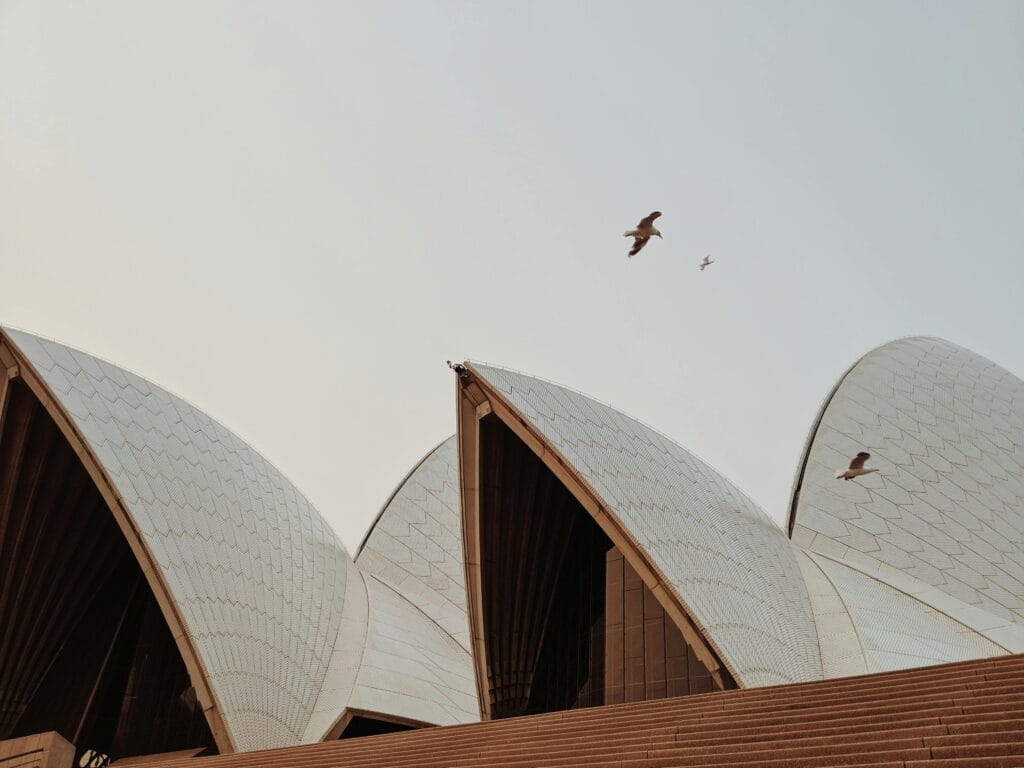Sydney Opera House
The Sydney Opera House, with its exceptional and distinctive design resembling a collection of sails on a boat, is a standout among cultural landmarks. Its unique architecture is sure to intrigue and fascinate anyone traveling to the city. Situated by the beautiful waters of Sydney, this iconic building is a must-visit. More than just a pretty landmark, it’s a vibrant hub for culture, hosting a variety of exciting events that draw people from all over.
Table of Contents
Where is the location of Sydney Opera House?

The Sydney Opera House is situated in Sydney, Australia, on a spot called Bennelong Point, right by the beautiful Sydney Harbour. It’s close to the famous Sydney Harbour Bridge and is one of the most recognizable buildings in the city, attracting visitors from all over the world.
Inscription of Sydney Opera House
The Sydney Opera House is an important building in Australia. It has been a UNESCO World Heritage Site since 2007, highlighting its cultural and historical value. This recognition makes visitors appreciate and respect the site. The Opera House has a unique design that looks like sails, making it a famous example of modern architecture from the 20th century. Danish architect Jørn Utzon designed it, and people around the world celebrate its beauty and creativity.
Why Sydney Opera House is famous for?
Sydney Opera House is famous cultural buildings where people can enjoy operas, music shows, ballets, and various other performances. They are important for keeping the arts alive and making sure everyone in the community can experience entertaining shows. Many opera houses also have beautiful designs, which makes them popular places for tourists to visit and admire the architecture in the cities they are located in.
The Opera House is more than just a building; it represents the creativity and innovation of Australia. Recognized around the world for its unique shape and beautiful design, this iconic landmark has made a significant mark on the arts. Built in the 20th century, it stands out for its stunning architecture and engineering. The Opera House symbolizes pride for Australians, serves as a vibrant part of the country’s cultural identity, and holds great meaning for society as a whole, inspiring and enriching all who visit.
Architecture of Sydney Opera House

In 1957, an important decision was made when an international panel chose Danish architect Jørn Utzon to design the Sydney Opera House. This decision changed how buildings were constructed. Utzon’s creative design and unique building approach encouraged architects, engineers, and builders to work together to bring his vision to life. Ove Arup played a key role in making Utzon’s grand idea a reality with the stunning Sydney Opera House. This building is famous for its beautiful design and the innovative engineering techniques used to create it. Its unique architecture and construction methods make it a global symbol of creativity and excellence.
Built in 1973, the Sydney Opera House is a true example of 20th-century design. It sits on a beautiful piece of land that extends into Sydney Harbour, standing out like a work of art amidst the water and scenery. Its distinctive look and inventive construction have left a lasting impact on the world of architecture.
Exterior Design
The Sydney Opera House is an attractive building made up of three unique, curved shapes that look like shells. These shapes cover two main performance spaces and a restaurant. The Opera House sits on a large platform and is surrounded by areas where people can walk and enjoy the views. Its creative design and stunning architecture make it not just a place for performances but also a remarkable piece of art in its setting by the water. It has become an iconic structure recognized all around the world.
Interior Design

Inside the Sydney Opera House, there are several different performance spaces, such as the Concert Hall, the Joan Sutherland Theatre, the Drama Theatre, the Playhouse, and the Utzon Room. These places host a variety of performances, including operas, symphony concerts, ballets, and theater shows, as well as other cultural events. Along with these performances, the Opera House also provide a range of dining options, bars, and shops, creating a full experience for visitors.
Preservation of Sydney Opera House
The preservation of the Sydney Opera House is shared responsibility for all who appreciate its cultural and historical significance. As an iconic symbol of Australia, efforts are made to secure its structural integrity and aesthetic appeal. Regular maintenance, restoration projects, and adherence to conservation standards help protect this UNESCO World Heritage site from environmental wear and tear, while also accommodating the millions of visitors it attracts each year. The ongoing commitment to its preservation is essential not only for future generations but also for the arts and community events it hosts, making us all part of a larger cause.
Why should you visit Sydney Opera House as a visitor?

Visiting the Sydney Opera House is a must-see! Its unique design by architect Jørn Utzon features a famous sail-like shape known around the world. The Opera House is also a lively cultural center where you can enjoy opera, ballet, theater, and concerts with local and international performers. You will see beautiful views of Sydney Harbour and the Harbour Bridge, making it a great place to visit at any time of day. Guided tours reveal interesting stories about the building’s history and design, helping you understand its significance. There are restaurants with amazing views and shops where you can buy special souvenirs to remember your visit.
Throughout the year, the Opera House hosts many events and festivals, so there’s always something exciting happening. It is conveniently located near other attractions like the Royal Botanic Garden and The Rocks, making it easy to explore more places in one trip. Overall, the Sydney Opera House offers a great mix of art, culture, and stunning architecture that everyone can enjoy!
Have you thought about visiting the Sydney Opera House?
If you’re looking for an unforgettable experience, consider visiting the Sydney Opera House to take in its breathtaking architecture and vibrant cultural events. Don’t miss out on this opportunity! When you’re planning your adventure, enhance your travel experience by using trusted websites like GetYourGuide, Trip.com, Agoda, Expedia and Hotels.com! These platforms offer a variety of enjoyable tours, activities, and accommodation options to suit every traveler’s needs.
- GetYourGuide offers a wide variety of unforgettable travel experiences. You can choose from tickets to Popular Attractions, Transportation Options, City Passes, Guided Tours, Hop-on Hop-off Bus Services, Water Activities, Day trips, and Trips that last several days in many locations around the world.
- Trip.com makes it easy to combine Flights and Hotels, Trains, Car Rentals, Airport Transfers and Attractions & Tours to create the perfect travel package tailored just for you.
- Agoda offers a wide range of accommodations and travel options to suit your needs. With user-friendly search features, you can easily find the perfect Hotel, Apartment, or Villa, Flights, Activities and Airport Transfer at competitive prices.
- Expedia to find the perfect travel deals and begin planning your next adventure with ease. Your unforgettable trip is just a click away!
- Hotels.com today to explore incredible deals and find the perfect housing for your dream trip! Your adventure starts here!
Start your journey with our reliable travel partners and unlock the best of Sydney Opera House and beyond!
Disclaimer
In this post, affiliate links are included and those links are associated with well-known travel companies such as GetYourGuide, Trip.com, Agoda, Expedia and Hotels.com. If you choose to purchase or book a service using those links, we may earn a commission at no additional cost to you. We focus on recommending products and services that are helpful to you and we appreciate your support!
Conclusion
We hope you find this information helpful for your next trip. If you want to learn more, check out our other travel blog posts. We cover many topics, including amazing places to visit and helpful travel tips. Whether you’re looking for hidden gems, new cultures, or helpful advice, there’s something for everyone.
Additionally, if you enjoyed the information we shared, don’t forget to explore our other travel product reviews to make your journey even better! Please take a moment to look through our previous posts and let your sense of adventure guide you on your next journey! We wish you happy travels and look forward to sharing more with you in our next blog post!




